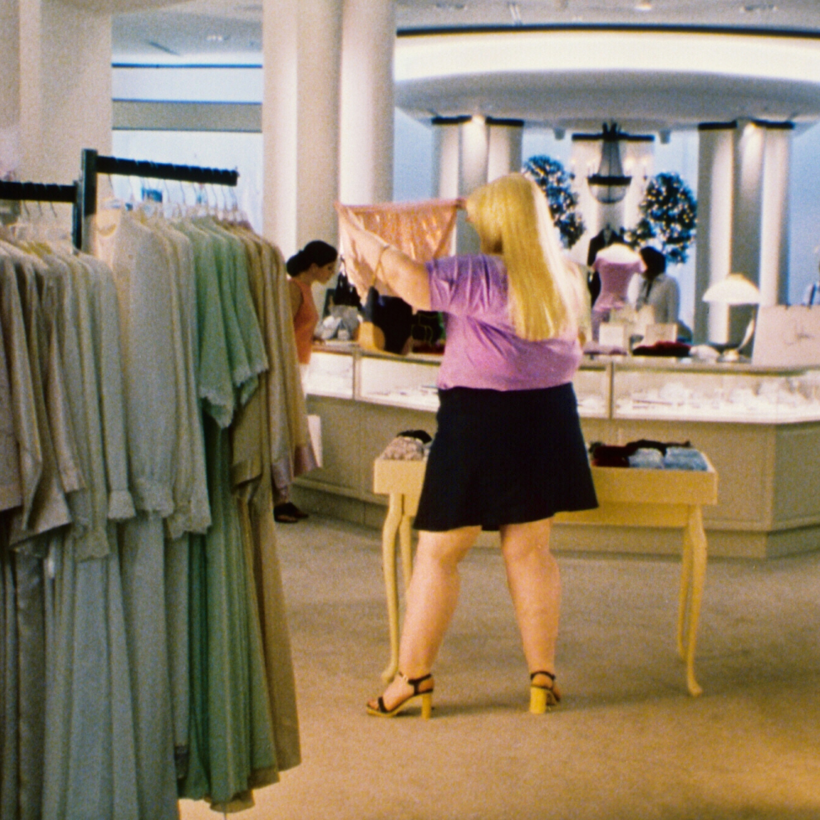Ivy Snitzer has screen presence—even on Zoom—with her safety pin earrings, nose piercing and reddish-purpleish hair. Yet no one saw her face in the hit film. Now 42, and an insurance agency owner in Philadelphia, Snitzer was Gwyneth Paltrow’s body double for the role of Rosemary in 2001’s Shallow Hal. While Paltrow wore a fat suit for scenes featuring her face, Snitzer’s body was used for close-ups of Rosemary’s arms, torso and thighs.
At the time, 20-year-old Snitzer was a Los Angeles-based acting student with aspirations to become an actor or comedian. “Mostly, I just wanted to be funny,” she says. One day, a friend from her improv class called her up because he had heard about “this thing.” To this day, Snitzer doesn’t know the wording of the Shallow Hal casting call. Without asking any questions, she drove with her friend to a room where casting directors “took a bunch of pictures.” A day later, Snitzer had a callback—she was invited to sit down with the film’s directors, the Farrelly brothers, and “just talk.”
“They just wanted to know that I was somebody who was cool to work with,” Snitzer says. Within the hour, she had gotten the job. She wasn’t fazed by the premise of the movie, in which womanizer Hal (Jack Black) is hypnotized so that he only sees inner beauty—the gag is that he falls in love with a woman who is overweight. It felt progressive to her at the time. “At that point, if you saw someone obese in a movie, they were a villain,” she says, whereas Rosemary “was cool, she was popular, she had friends.”
Snitzer, who has since lost a significant amount of weight, has zero negative memories of shooting the film. “It was so exciting. It was just fun to be part of a movie—there are so few people who actually get to do that,” she says. The cast and crew “treated me like I really mattered, like they couldn’t make the movie without me” and Snitzer was made to “feel really comfortable” when her body was being filmed. Black, she says, was “a delightful person” and Paltrow was “really nice” (she regularly complimented Snitzer’s acting). It didn’t cross her mind to be offended by the film’s jokes about her size because she made those kinds of jokes, too.
But, she says, “it didn’t occur to me that the film would be seen by millions of people.” And when Shallow Hal was released in 2001, “it was like the worst parts about being fat were magnified. And no one was telling me I was funny.”
To promote the film, Snitzer was invited to give TV and magazine interviews and, although initially excited, she soon realized it also acted as an open invitation to strangers to approach her on the street. Many were angry that Snitzer had said, “It is not the worst thing in the world to be fat”; some claimed she was promoting obesity. One person found her address and sent her diet pills. There were love letters, too—someone mailed her a symphony they had composed especially for her.

“”I got really scared,” she says. “I was like: maybe I’m done with the concept of fame, maybe I don’t want to be an actor. Maybe I’ll do something else.”
She moved back to New York to live with her parents, where she worked as a bartender, occasionally performing comedy, and was briefly a catering waiter. Casting directors kept offering her roles but they were “mean … I didn’t want to play a woman who was so ugly and lonely that she molested young boys because that was the only way she could get affection.” This, Snitzer says, was the antithesis of why she had sought fame in the first place. “I just want to make people laugh; I don’t want to make people sad.”
The trouble is, as I discover speaking to Snitzer, that the story of her post-Shallow Hal life is sad. Less than two years after Shallow Hal was released, she was “technically starving to death”. In 2003, she had gastric band surgery, which reduced the size of her stomach and restricted what she could eat. But shortly after the procedure, the band slipped, “and I got a torsion—like dogs get and then die.”
The timing couldn’t have been worse. Snitzer didn’t have health insurance, so she had to get a temp job at an asset management firm in Beverly Hills (she had moved back to LA with her comedy writing partner). She also had to wait for her probation period to end before she was given health insurance, meaning she spent three months unable to consume anything thicker than water without throwing up. She lived off sports drinks and watered-down nutritional shakes.
“I was so thin you could see my teeth through my face and my skin was all gray,” she says. “And I was just so bitchy all the time. I kind of alienated a lot of my friends. My mother was also dying; it was bleak. Humans shouldn’t have to experience how very bleak that particular time in my life was.”
She became so malnourished that doctors were not able to perform surgery to remove her band; first they had to give her a peripherally inserted central catheter (PICC) line to provide her with liquid nutrition. For four months, she had to hook herself up to an IV fluid bag every night after work, in order to, as she puts it, “not die.” Due to further complications, doctors ultimately performed a gastric bypass operation to remove part of her stomach. To this day, she has to eat “weird tiny portions” and can’t eat and drink at the same time.
I ask Snitzer why she got the initial weight loss surgery. “I don’t know,” she says. Then: “Because I was supposed to! If you’re fat, you’re supposed to try to not be.” She cites writer Roxane Gay’s idea of a “good” fat person, someone who orders salads and never eats burgers in front of other people. Snitzer thought getting the surgery meant she was being good.
“I was so thin you could see my teeth through my face and my skin was all gray.”
Filming Shallow Hal was empowering for Snitzer because of what happened off-screen, not on it. “Out of all of the fat people in the world that they could have hired for that job, they hired me, because of my personality,” she says. “Before, I had to fight really hard to be seen as a personality and not just my size.”
She also says that undergoing a weight loss procedure 15 months later wasn’t connected—it was more of a coincidence. A doctor told her she wouldn’t live to see 40 without surgery and she thought: “Fantastic. Something that’ll fix it. That’s fine.”
Snitzer first noticed herself gaining weight around the age of 10. She describes herself as part of the “ketchup is a vegetable generation,” who was “randomly the first very obese person” in her family. She could brush it off when other kids were mean about her body but hated when adults tried to offer well-intentioned advice. She counted calories as a teen and dieting eventually transitioned into a disorder. Restricting started to feel good. “I felt like I’d got some control over the situation that everyone was telling me to control.”
By the time she was filming Shallow Hal, she felt insecure but she also felt confident. “I wasn’t body positive, because it didn’t really exist that way. I was kind of ‘me positive,’ because I was like: I’m funny, that’s good enough!” Still, in an attempt to be “good,” Snitzer ate healthily on set. During filming, a senior person in production hugged her and remarked that she was losing weight. Snitzer was happy; he wasn’t. He reminded her, “This entire movie is based on you not losing weight!”
When the filming ended, Snitzer was committed to the idea of being “a good fatty.” “I hated my body the way I was supposed to,” she says. “I ate a lot of salads. I had eating disorders that I was very proud of.”
After surgery and before the gastric band slipped, she expedited her weight loss by exercising excessively, purging and restricting her calorie intake. “It didn’t occur to me that I was supposed to be ashamed of those behaviors.”

She says that when she was overweight, people would avoid eye contact with her, but when she was at her sickest—so malnourished that she needed medical intervention to stay alive—“everything was so different.” People smiled at her, moved out of her way and paid for her coffee. “It was really nice to be treated well.”
She feels “scared and sad” that watching Shallow Hal may have made overweight young girls feel bad, but sometimes she receives complimentary Instagram messages from women saying she was the first fat representation they ever saw on-screen.
After the gastric band slipped, the behavioral disorders calmed down somewhat. “Because I couldn’t consume anything, my mindset became more about how much I could manage to consume, not how little.” She gained weight after her second surgery and resumed socializing with friends. Six months later, she met her husband, who “came over for a sleepover on the second date and kind of never left”. The couple have a 13-year-old daughter who has never expressed a desire to watch Shallow Hal. And Snitzer says, she’s “not going to run out and rewatch it.”
In fact, the only time she ever saw the film was when it premiered. She wore an outfit her mom had made, which meant, “I finally had a coat that had sleeves long enough.” She planned to sneak around the back but the cast encouraged her to walk the red carpet, “which, again, is extremely cool when you’re a 20-year-old kid.” She doesn’t remember how it felt to watch the film.
“I love that it’s a cool thing I did one time,” she says—it’s a fun story she tells over drinks. “It didn’t make me feel bad about myself. Until, you know, other people started telling me I probably should have felt bad about myself.”
The last thing I want to be is one of those people but, a few days after our initial call, I call Snitzer back to say I’m struggling to get my head around the fact that her weight loss surgery came so soon after Shallow Hal premiered; I can’t understand how the latter wasn’t connected to the former.
“I know,” Snitzer says. “I’m sure it was … I’m sure I wanted to be small and not seen. I’m sure that’s there, but I don’t ever remember consciously thinking about it.”
Today, she doesn’t regret the surgery, doesn’t worry too much about eating, and likes to think she has “found a lot of stability in between the two extremes” of her past. She has cheered the rise of the body positivity movement and is inspired by her daughter’s outspoken generation. But her story was never simple and she says her relationship with her body “changes every day.”
“I was always my personality,” she adds. “I’ve always been a personality in this body.”
Amelia Tait is a features writer and contributor to The Guardian, Wired, and The New Statesman, among others




